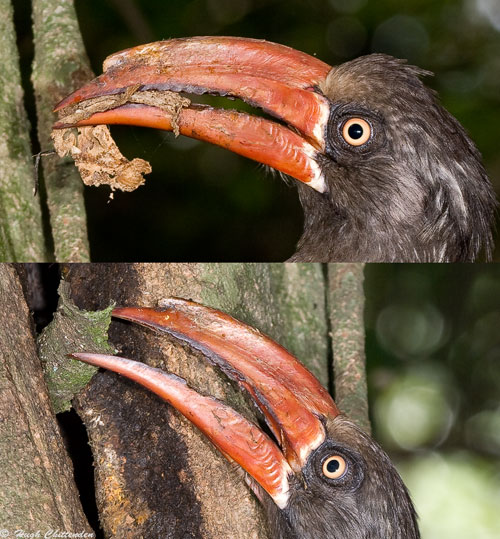Topic : Land Birds
Article 42 ![]() 21 January 2008
21 January 2008
Crowned Hornbill breeding cycle, vertebrate prey and fruit – Part 3
Chameleon prey
Although 80 – 90% of the prey delivered to the nest was invertebrates, small vertebrates such as chameleons and frogs added significantly to the overall prey mass fed at the nest. Dwarf chameleons are regularly brought to the nest as prey and the local race of Dwarf Chameleon, as yet un-named (Chameleons of southern Africa, Tolley & Burger, 2007), is extremely geographically restricted and only occurs in the forests surrounding Eshowe, namely Dlinza, Ngoya and Ntumeni.

Large Chameleon prey that is usually only fed on by adults, and too large to be fed to young nestlings.

Small Dwarf chameleons are regular prey items.
Millipedes
Part 2 shows a photograph of a red millipede, one of the more common millipede species found in the forests and adjacent areas of central KwaZulu-Natal and they are not uncommon prey items of hornbills during the breeding season. This is unusual as most birds to not normally touch millipedes. If they are being used as a food source (which we doubt), perhaps this species of millipede is less toxic than their large black coloured relatives that birds seem to avoid as a source animal prey. It is also possible (and seems likely) that the millipedes were not being eaten but rather being crushed and added to the nest debris where their fluids would act to keep away mites, flies, ants etc!. Hornbill nests are horribly messy and smelly places that contain lots of fragments of food, feathers, the remains of eggs and even dead chicks that would attract parasites and predators. It is probable that many hornbill species use some kind of chemical deterrent to keep away mite, ants and even fungal buildup.
Monteiro's Hornbills for example build up a thick layer of crushed millipedes before the females start laying, while other Tockus hornbills use layers of acacia pods or bark and most of these forms of nest lining are unpleasant to insects and mites. Studies in Namibia have shown that the great majority of hornbill nests were free of ants, flies and mites, this being despite the fact that some trees are covered in predatory ants that give nasty bites when you climb to the nest. If they can get their mandibles into human flesh, small hornbill chicks would be easy prey. Occasionally, however, some nests have been being abandoned when they are heavily infested with mites, so it’s possible the adults failed to add the right deterrent chemicals to the nest chamber.

Frogs are occasionally fed to the large chicks in the nest.
Fruit
A small percentage of fruit was included in the diet during breeding season but fruit intake of African Crowned Hornbills appears to be higher during the winter months when animal food is scarce and this species is forced to move to warmer habitats in adjacent low-lying regions where they feed on amongst other things, Euphorbia fruit. Prey was collected by the adults both within the forest and on the forest margins.

A small percentage of food brought to the nest comes in the form of fruit.

Pieces of dry bark are brought daily and added by the female as nest lining.
About half way through the nestling period, the female’s flight feathers have grown sufficiently for her to break out the nest and help the male with the demanding task of prey collection. Amazingly, the chicks then re-plaster the nest entrance hole to protect themselves from predation for the final few weeks that they remain in the nest. During this study, it was not possible to determine what tree species were being used to collect bark for nest lining.
